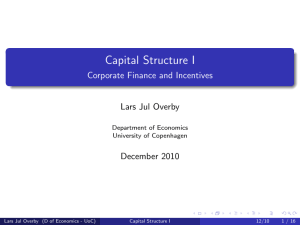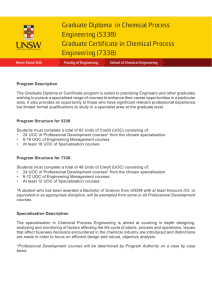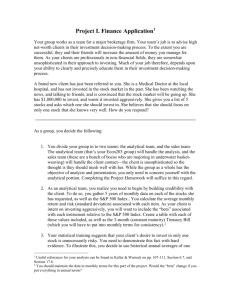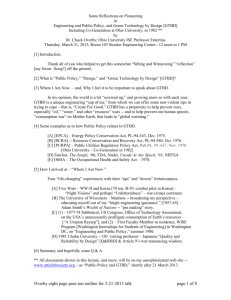CAPM, Factor Models and APT
advertisement
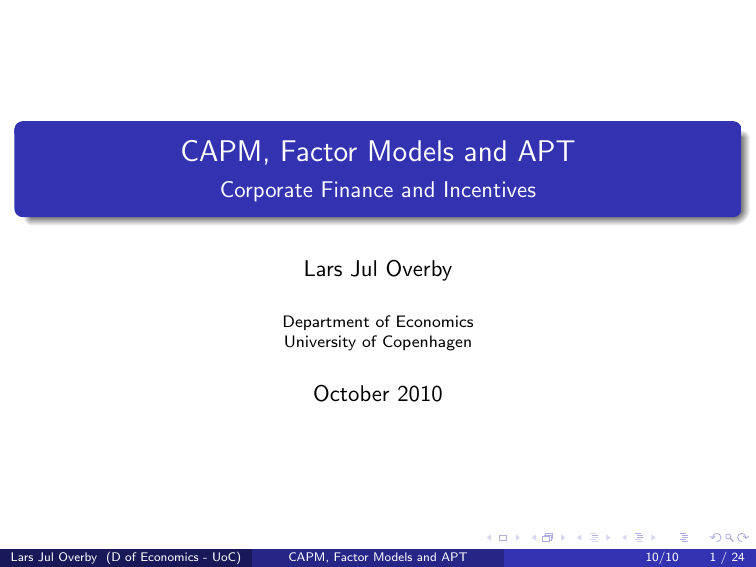
CAPM, Factor Models and APT Corporate Finance and Incentives Lars Jul Overby Department of Economics University of Copenhagen October 2010 Lars Jul Overby (D of Economics - UoC) CAPM, Factor Models and APT 10/10 1 / 24 Capital asset pricing model Assumptions Like for the Mean-Variance assumptions: Markets are frictionless Investors care only about their expected mean and variance of their returns over a given period Additional assumption required for CAPM: Investors have homogeneous beliefs Lars Jul Overby (D of Economics - UoC) 10/10 2 / 24 Capital asset pricing model Implications The tangency portfolio is the same portfolio for all investors i.e. all investors hold the risky assets in the same relative proportions. The tangency portfolio must be the market portfolio The CAPM ri βi Lars Jul Overby (D of Economics - UoC) = rf + β i R M − rf eM cov e ri , R = eM var R 10/10 3 / 24 Empirical results of the CAPM Several problems of which the most noticeable are: Small Firms → Higher Return Reduced since publication of the effect in early ’80s Low Market Value/Book Value → Higher Return Also reduced since publication in late ’80s Momentum - past winning stocks outperform past losing stocks Tendency still exists despite publication in early ’90s Insignificance of Betas when above mentioned effects are accounted for Lars Jul Overby (D of Economics - UoC) 10/10 4 / 24 Factor models The CAPM stems from a theoretical background - an equilibrium model But it doesn’t fit empirical asset returns well What if assets are in fact exposed to other systematic risk factors, which affect the expected return hereon Factor models Let’s take a more statistical approach. Let’s look at the actual behaviour of stock returns and their comovements. Lars Jul Overby (D of Economics - UoC) 10/10 5 / 24 Arbitrage Pricing Theory (APT) APT was conceived by Ross (1976) The model starts from a statistical point of view, not a theoretical one like the CAPM Idea: Not all types of risk are captured by the one market risk term of the CAPM There is a big common component to stock returns - the comovement with the market Beyond the market, some groups of stocks move together - like computer stocks, small stocks, utility stocks etc. Finally, the individual stocks have some idiosyncratic movement The claim of the APT is not that CAPM is incorrect – if CAPM’s assumptions are correct it will hold But unlike CAPM, APT does not require that all investors only care about mean and variance Furthermore, if there is more than one source of systematic risk, maybe a richer model could give more insights Lars Jul Overby (D of Economics - UoC) 10/10 6 / 24 Factor models A linear relationship between factors and assets is assumed We have N assets and K factors, with N > K The return of asset i is: e ri = αi + β i1 Fe1 + β i2 Fe2 + .. + β ik Fek + e εi Where αi is the intercept for the factor model, β ij is asset i 0 s factor beta (factor sensitivity) to factor j, Fej is the level of factor j, and e ε i is an idiosyncratic risk adherent to asset i Lars Jul Overby (D of Economics - UoC) 10/10 7 / 24 Assumptions In order for e ε i to be idiosyncratic (firm specific) it must hold that E (e εi ) = 0 cov (e εi , e ε j ) = 0 for i 6= j cov e ε i , Feh = 0 So the idiosyncratic risks are independent, meaning that they are diversifiable, which is key to the theory Lars Jul Overby (D of Economics - UoC) 10/10 8 / 24 Factor assumptions For simplicity we assume that the factors in our model have been demeaned E ( Fh ) = 0 This is in line with the idea that the factors proxy for new information about relevant variables Often, we also work with uncorrelated factors cov Feh , Fek = 0 for h 6= k Lars Jul Overby (D of Economics - UoC) 10/10 9 / 24 Expected return The question is, what is the expected return of asset i? E (e ri ) = E αi + β i1 Fe1 + β i2 Fe2 + .. + β ik Fek + e εi = αi But what is αi ? The idea is, that the value of αi depends on the exposure of asset i to the various factors. But how? Two things matter How exposed is the asset to the risk factors? Could fx be determined by running regressions of asset returns on the factors What does a unit of risk ”cost”? The risk premium? Lars Jul Overby (D of Economics - UoC) 10/10 10 / 24 Pure factor portfolios The expected return on asset i E (e ri ) = rf + β i1 λ1 + β i2 λ2 + .. + β ik λk = αi We want to find the risk premiums, the λ0 s. The easiest way to solve this is to create pure factor portfolios. In this way we can isolate the amount of risk in a given portfolio and link it to one single risk factor. This will allow us to decide on the risk premium on that particular risk factor. Remember, when the k factors are uncorrelated var (e ri ) = β2i1 var Fe1 + β2i2 var Fe2 + ... + β2i3 var Fe3 + var (e εi ) Lars Jul Overby (D of Economics - UoC) 10/10 11 / 24 Portfolio math Use the fact that the factor beta of a portfolio on a given factor is the portfolio-weighted average of the individual securities’ betas on that factor ep R αp β p1 β p2 = = = = αp + β p1 Fe1 + β p2 Fe2 + .. + β pk Fek + e εp x1 α1 + x2 α2 + ... + xN αN x1 β 11 + x2 β 21 + ... + xN β N1 x1 β 12 + x2 β 22 + ... + xN β N2 . . Assume the firm specific components can be diversified away (see result 6.1) E (e εp ) = 0 var (e εp ) ≈ 0 Lars Jul Overby (D of Economics - UoC) 10/10 12 / 24 Pure factor portfolios Create pure factor portfolios ep1 = αp1 + 1 ∗ Fe1 + 0 ∗ Fe2 + .. + 0 ∗ Fek R β p11 = x11 β 11 + x12 β 21 + ... + x1N β N1 = 1 β p12 = x11 β 12 + x12 β 22 + ... + x1N β N2 = 0 . . . β p1k = x11 β 1k + x12 β 2k + ... + x1N β Nk = 0 Do this for each factor. This will give us portfolio weights for creating pure factor portfolios. Lars Jul Overby (D of Economics - UoC) 10/10 13 / 24 Pure factor portfolios The expected return on a pure factor portfolio is then ep1 E R = rf + 1 ∗ λ1 + 0 ∗ λ2 + .. + 0 ∗ λk = αp1 = x11 α1 + x12 α2 + ... + x1N αN So the risk premium on F1 is λ1 = x11 α1 + x12 α2 + ... + x1N αN − rf Carry on to find value of all risk premiums Lars Jul Overby (D of Economics - UoC) 10/10 14 / 24 Tracking portfolio Combine the pure factor portfolios and a risk free asset to construct tracking portfolios which have the same risk exposures as some given risky asset i. The weights on the pure factor portfolios in the tracking portfolio are determined by the risk exposure of the risky asset i. The portfolio weight on the risk free asset is such that the weights in the tracking portfolio sum to 1. The expected return on the tracking portfolio is eTP = rf + β i1 λ1 + β i2 λ2 + .. + β ik λk E R Lars Jul Overby (D of Economics - UoC) 10/10 15 / 24 Arbitrage An arbitrage opportunity exists if the expected return on asset i differs from that of the tracking portfolio E (e ri ) = E αi + β i1 Fe1 + β i2 Fe2 + .. + β ik Fek = αi e 6= rf + β i1 λ1 + β i2 λ2 + .. + β ik λk = E RTP Lars Jul Overby (D of Economics - UoC) 10/10 16 / 24 Arbitrage Pricing Theory According to the arbitrage pricing theory, such arbitrage opportunities cannot exist This implies that the risk premiums are the same for all assets λ1i λ2i λki Lars Jul Overby (D of Economics - UoC) = λ1j for ∀ i, j = λ2j for ∀ i, j . . = λkj for ∀ i, j 10/10 17 / 24 Arbitrage Pricing Theory This gives us the APT model r i = rf + β i1 λ1 + β i2 λ2 + .. + β ik λk for all investments with no firm-specific risk Assumptions Returns can be described by a factor model There are no arbitrage opportunities There are a large number of securities, so it is possible to form portfolios that diversify the firm-specific risk of individual stocks The financial markets are frictionless Lars Jul Overby (D of Economics - UoC) 10/10 18 / 24 Implementation APT can be implemented in three ways: 1 Using statistical methods to synthetically create “factors” that best fit the observed stock price variations 2 Using macroeconomic variables (after adjusting to make sure that the expected levels are 0) 3 Using firm-specific characteristics, such as firm size, as proxies for factor sensitivities Lars Jul Overby (D of Economics - UoC) 10/10 19 / 24 Using statistics Factor analysis We will not go into how this is done, but. . . Covariances between stock returns are used to find the factor structure (factor levels and factor betas for each stock) Gives the best fit by construction However, makes interpretation impossible And in case something changes (like a company entering a foreign market, thus suddenly making it vulnerable to a certain FX rate), it is next to impossible to explain the implications for the factor sensitivities Lars Jul Overby (D of Economics - UoC) 10/10 20 / 24 Macroeconomic variables Use macroeconomic variables as factors However, their levels must be adjusted: They should ideally have mean 0, meaning that, for instance, GDP growth can not be used directly as a factor The factor should be: GDP growth – consensus estimate of GDP growth This makes them hard to find – where to get the consensus estimates? On the other hand, this method has the benefit that interpretation is quite straightforward Lars Jul Overby (D of Economics - UoC) 10/10 21 / 24 Factors used Changes in monthly growth rate of GDP (reflects future demand for output) Changes in default risk premium, measured as spread between yields of AAA and Baa bonds (reflects concern about companies defaulting) Changes in the slope of the term structure (reflects expected future interest rates) Unexpected changes in the price level (alters the real value of contracts) Changes in expected inflation (reflects government policy and interest rates/discount rates) And many, many others... Lars Jul Overby (D of Economics - UoC) 10/10 22 / 24 Firm characteristics Idea: certain firm characteristics are correlated with factor sensitivities (hard to measure) and therefore also to risk premia (easy to measure) Use these as proxies for factor sensitivities Transcends the problem of changing sensitivities and lack of intuition that factor analysis suffers from Also transcends the problem of factor changes having to be unexpected that using macroeconomics variables suffers from Lars Jul Overby (D of Economics - UoC) 10/10 23 / 24 Fama-French three factor model One of the best models for explaining stock price returns - although it too has problems Explanatory variables: Market return (CAPM beta) Market capitalization of the stock – small-cap stocks outperform large-cap stocks Market to book of the stock – low market to book stocks (value stocks) outperform high market to book stocks (growth stocks) Important: the interpretation is NOT that investors are compensated for holding small-cap stocks or low market to book stocks (then why hold anything else?), but rather that small-cap stocks are exposed to a certain risk that you are compensated for holding Lars Jul Overby (D of Economics - UoC) 10/10 24 / 24
